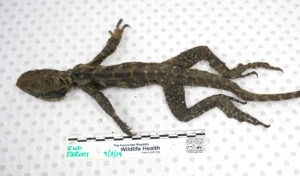Deadly Fungal Disease Could Threaten Australia’s Iconic Lizards
 A team of scientists have announced the discovery of a deadly fungal disease affecting wild lizards across Australia.
A team of scientists have announced the discovery of a deadly fungal disease affecting wild lizards across Australia.
The condition, sometimes referred to as ‘Yellow Fungus Disease’, is dreaded by captive reptile keepers across the globe, who know all too well how contagious and deadly the infection can be. This research, published overnight in Scientific Reports, describes the first cases of the disease detected in the wild anywhere in the world.
The cause of the outbreak is a fungal pathogen, Nannizziopsis barbatae, which feeds on keratin, the main protein in skin. Infection causes severe skin lesions and can progress to systemic infection. Affected lizards have been identified in Western Australia, Victoria, New South Wales and Queensland, with focal outbreaks in Brisbane parklands.
The research was led by USC Science Honours student Nicola Peterson, who worked as part of an interdisciplinary team that included USC academics Associate Professor Celine Frere and Dr İpek Kurtböke, Dr Karrie Rose of the Taronga Conservation Society, Dr Stephanie Shaw of the Department of Environment and Science, Dr Tim Hyndman of Murdoch University, Professor Lynne Sigler of the University of Alberta, and Brisbane-based veterinarian Dr Josh Llinas.
“It’s awful to see what this infection does to reptiles,” said Ms Peterson. “The lizards we examined presented with extensive skin lesions, severe emaciation, and loss of toes and tails. They were in terrible condition and clearly suffering.”
Sadly, the infection usually leads to death, even with treatment. Professor Sigler, a world-leading mycologist, said, “The presence of this contagious fungal pathogen in free-living Australian lizards poses a serious conservation threat.”
Reptiles are comparatively understudied and often elusive, so there is real potential for population impacts to occur undetected. Public vigilance can play an important role in identifying and limiting impacts of the disease. Dr Karrie Rose, who is the manager of Taronga’s Australian Registry of Wildlife Health said, “This research highlights the importance of monitoring and investigating emergent disease to protect our iconic species and environments.
The community has a role in this process and can report unusual signs in wildlife to the Animal Disease Watch Hotline on 1800 675 888, or their Wildlife Health Australia State Coordinator.” (https://wildlifehealthaustralia.com.au/AboutUs/ContactDetails.aspx)
This group of fungi, Nannizziopsis species, includes several species known to cause disease and death in reptiles. Although rare cases of infection have also been reported in humans, the species affecting reptiles and humans are different. Ms Peterson’s research showed that Nannizziopsis barbatae was not able to grow at human body temperature, largely mitigating concerns that the fungus could pose a threat to humans. Nonetheless, it is important that only trained individuals using appropriate biosafety measures should handle reptiles with suspicious skin lesions.
Dr Frere said the USC-led study described the first cases of Nannizziopsis infection in free-ranging reptiles, details a new method to culture fungi, and highlights characteristics of the fungus that makes it a high-risk threat to wild reptile populations. “This was the first step in our research into this novel fungal pathogen,” said Dr Frere, who recently received a $967,439 Australian Research Council Future Fellowship for further research into fungal diseases in animal populations. “USC will continue to lead research into how the social behaviours of animals contribute to the spread and transmission of infectious fungal diseases.”
